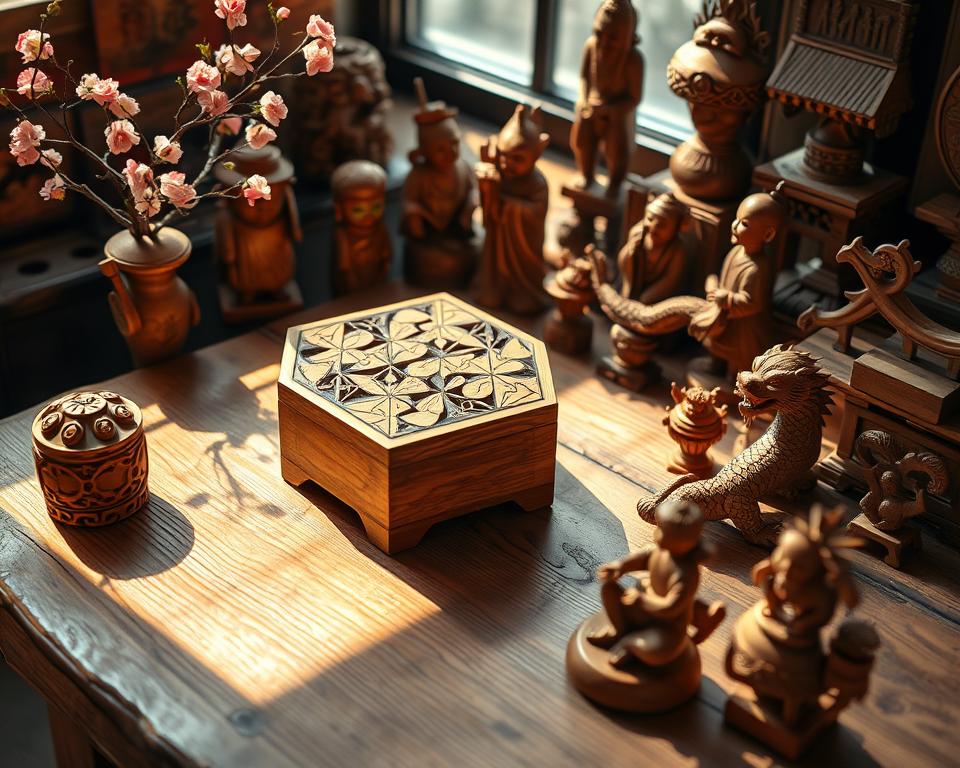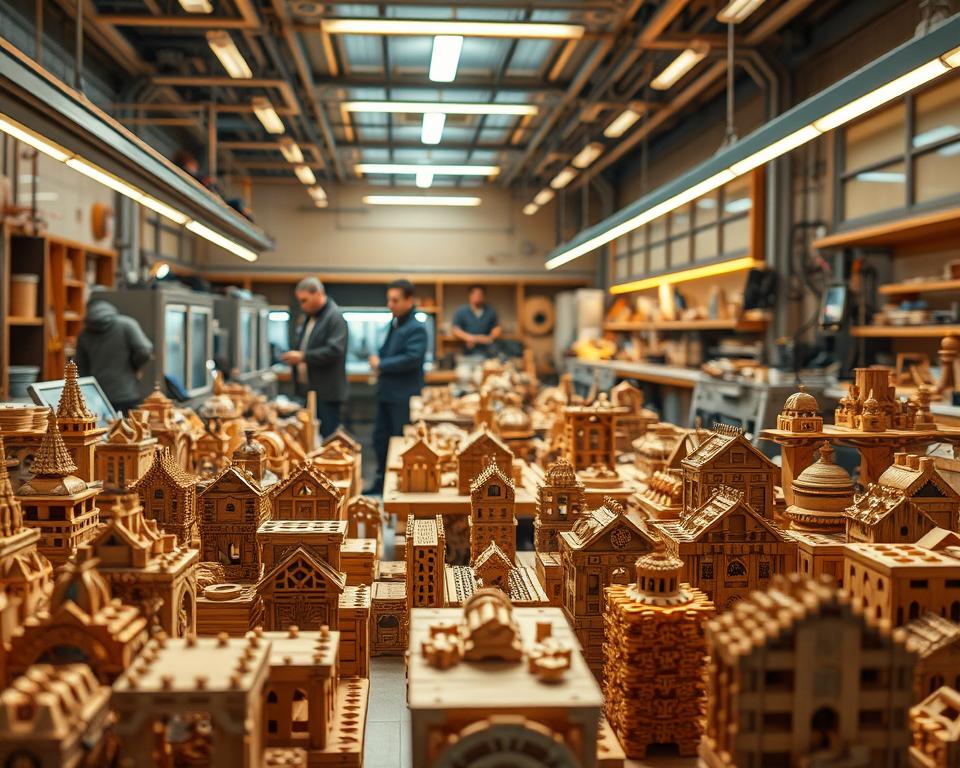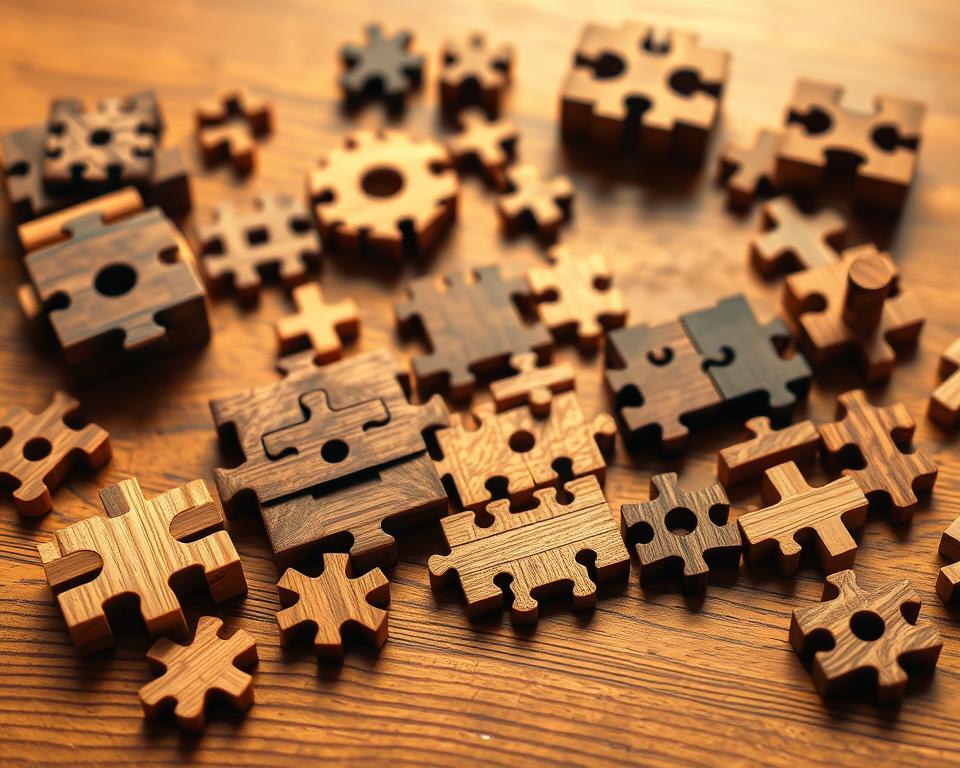For centuries, intricate handcrafted designs have captivated minds and hands alike. These artful creations blend cultural heritage with clever problem-solving, offering both beauty and brainpower in one elegant package.
What makes these pieces so special? They’re more than just games—they’re a bridge between past and present. Each carved shape tells a story, merging design mastery with timeless appeal. Whether you’re a collector or a casual enthusiast, there’s magic in how wood transforms into interactive art.
Key Takeaways
- Discover the cultural significance behind these handcrafted treasures
- Learn how craftsmanship meets intellectual challenge
- Explore the balance between ancient techniques and modern interest
- See why these items remain popular worldwide
- Understand the symbolism hidden in their designs
Introduction to Asian Wooden Puzzle Traditions
What looks like a simple box often hides layers of clever craftsmanship. These pieces are more than games—they’re functional art, with designs refined over 200 years. Some serve as secret containers, while others challenge the mind with interlocking parts.
In Japan’s Hakone region, over 100 artisans keep these traditions alive. Their work blends practicality with symbolism, like puzzle boxes that require precise steps to open. Chinese designs, meanwhile, often focus on disentangling complex wooden shapes.
Both styles reflect regional values. Japanese creations emphasize patience and precision, while Chinese puzzles showcase geometric ingenuity. For collectors, each piece offers a glimpse into the culture that shaped it.
The Ancient Roots of Asian Wooden Puzzles
Long before modern toys existed, clever minds crafted interactive challenges from nature’s resources. These designs weren’t just playthings—they reflected cultural values and intellectual pursuits.
Early Beginnings in China and Japan
In China’s Zhou Dynasty, scholars used carved tools to teach logic. These early prototypes laid the groundwork for later creations. By the 19th century, Japan’s sikake-bako boxes stored workers’ tools, blending utility with secret mechanisms.
Hangzhou’s silk parasols, over 2,000 years old, inspired intricate patterns. Like oil-paper umbrellas in weddings, these items bridged art and function.
Spread Across Asia
Trade routes carried designs to Korea and Thailand. Each region added local flair:
- Chinese puzzles emphasized geometric complexity
- Japanese versions focused on precision and patience
- Korean artisans incorporated natural wood textures
This exchange sparked a woodworking renaissance across the world. Today, collectors treasure these pieces for their history and craftsmanship.
The Art of Crafting Japanese Puzzle Boxes
Master artisans transform raw timber into mind-bending treasures through meticulous craftsmanship. These Japanese puzzle boxes demand over 80 steps to create, ensuring each piece becomes a generational heirloom. The process honors nature, history, and precision in equal measure.
Materials and Techniques
Hakone’s artisans source high-quality wood from sustainable forests, favoring unpainted grains like cherry and walnut. Each plank undergoes strict humidity control to prevent warping—a lesson learned over centuries.
Traditional hand tools carve delicate joints, though some modern makers use laser cutting for efficiency. Legendary craftsman Takajiro Ohkawa revolutionized designs with multi-step mechanisms, adding layers of challenge.
The Role of Yosegi-Zaiku Mosaic
The Yosegi-Zaiku mosaic technique dazzles with geometric patterns, weaving 10+ wood types into intricate visuals. Thin veneers are dyed naturally, then stacked and sliced to reveal repeating motifs.
This artistry isn’t just decorative—it tests solvers’ focus. Patterns often hint at hidden mechanisms, blending beauty with brainpower. Today, these mosaics symbolize the harmony of tradition and innovation.
Cultural Significance of Asian Wooden Puzzles
Beyond entertainment, these creations carry deep cultural meanings woven into their designs. They serve as vessels for symbolism, storytelling, and sacred practices across generations.
Symbolism and Traditions
Red-lacquered items frequently appear in weddings, believed to ward off misfortune. Intricate boxes symbolize fertility, requiring specific movements to unlock—mirroring life’s complex journeys.
Inspired traditional Japanese funeral customs use contrasting colors:
- Purple umbrellas represent mourning
- White patterns signify purity
- Crane motifs promise longevity
Puzzles in Daily Life and Ceremonies
Samurai employed 50-step boxes for secure message delivery. Each turn acted as an encryption method, protecting sensitive information during feudal eras.
Tea ceremonies incorporated simpler pieces to cultivate mindfulness. The deliberate ways of manipulating them mirrored the ritual’s meditative pace.
Today, artisans preserve these connections by embedding symbolic patterns. A single piece might combine protection, wisdom, and celebration through its carvings.
Types of Asian Wooden Puzzles
From secret compartments to interlocking shapes, these handcrafted challenges come in many forms. Each style reflects its cultural roots while testing problem-solving skills in unique ways. Collectors prize them for their craftsmanship and clever designs.
Japanese Puzzle Boxes (Himitsu-Bako)
These puzzle boxes use sliding panels to hide compartments, requiring precise moves to unlock. Modern 6-sun boxes (18cm wide) demand up to 66 steps to solve. The 1536-move record holder showcases the extreme complexity artisans create.
Chinese Wooden Interlocking Puzzles
Unlike sliding mechanisms, Chinese designs create intricate burr puzzles with interlocking pieces. Ming Dynasty pagoda puzzles are rare collector’s items. Their geometric patterns challenge even seasoned solvers.
Korean Wooden Brainteasers
Korean *noli* puzzles often take animal shapes, carved from traditional wooden materials like persimmon. Solutions mimic natural movements, blending artistry with logic. These pieces highlight regional craftsmanship.
Whether you prefer sliding, assembling, or disentangling, each type offers a distinct mental workout. Their enduring appeal lies in how they merge beauty with brainpower.
The Masters Behind the Craft
Behind every intricate creation stands a master whose skill transforms ordinary materials into extraordinary challenges. These artisans blend precision with creativity, ensuring each piece carries their unique signature.
Notable Artisans: Takajiro Ohkawa and Tatsunosuke Okiyama
Takajiro Ohkawa revolutionized designs in the 1870s with nonlinear step sequences. His puzzles required solvers to think beyond straight-line movements, adding layers of complexity.
Tatsunosuke Okiyama, another legend, became famous for his *kuroasa* star patterns. These geometric designs weren’t just decorative—they hinted at hidden mechanisms, testing solvers’ attention to detail.
Apprenticeship and Legacy
Becoming a master takes time. Traditional apprenticeships last three years, but crafting complex boxes demands seven. Few young artisans commit to this path today, risking the loss of centuries-old techniques.
Efforts like Kyoto’s Women’s Woodcraft Initiative aim to revive these skills. By training new makers, they ensure the craft survives for passed generations.
The Evolution of Puzzle Box Designs
What began as basic locked containers evolved into mind-bending challenges over centuries. Early Edo-period designs required just four moves, while contemporary versions demand 66 precise steps. This progression shows how artisans continuously reinvent their craft.
From Simple to Complex Mechanisms
The first unique puzzle boxes stored valuables with straightforward slides. By the 1800s, craftsmen added collapsible joints inspired by umbrella frames. These let panels move in unexpected directions.
Modern masters build on inspired traditional techniques. Tokyo’s Akira Yoshida crafts transparent resin boxes with laser-cut maple interiors. His work blends old-world precision with futuristic materials.
Modern Innovations
Today’s designers push boundaries in exciting ways:
- RFID-locked hybrids merge physical and digital security
- Augmented reality apps guide solvers through tricky steps
- Sustainable bamboo replaces rare woods without losing appeal
These advances ensure the art form stays relevant. Yet even high-tech versions honor centuries of craftsmanship at their core.
How to Solve a Japanese Puzzle Box
Unlocking a Japanese puzzle box feels like cracking a secret code from centuries past. These clever containers reward patience and precision, offering multiple ways to approach their hidden mechanisms. Before starting, remember: force is the enemy of craftsmanship.
Understanding Sun and Steps
The “sun” measurement indicates box size, not difficulty. A 4-sun box (12cm wide) often has simpler moves than larger counterparts. Steps refer to sequential movements needed to open it.
Two main types exist: linear (straightforward sequence) and nonlinear (varied directions). Beginners should track each slide’s direction. Many boxes follow seasonal or numerical patterns in their steps.
Tips for Beginners
Start your experience right with these pointers:
- Place thumbs at the box’s sides – pushing panels inward can jam mechanisms
- Reset after three failed attempts to avoid frustration and damage
- Choose 4-sun boxes with under 15 moves for initial success
- Never force openings – delicate Yosegi patterns scratch easily
Listen for subtle clicks indicating correct movements. Like learning an instrument, regular practice builds intuition for these tactile challenges.
The Role of Wood in Asian Puzzle Traditions
The choice of material defines both the challenge and charm of these crafted treasures. Each type of wood brings unique qualities, shaping how a piece feels, functions, and ages over time. Artisans prioritize sustainability and texture, ensuring every creation honors nature’s gifts.
Selecting the Right Wood
Hinoki cedar is prized for its fresh aroma, while cherry wood offers lasting durability. Kiri (paulownia) stands out for its lightness, enabling thin sliding panels in intricate designs. Zebrawood’s bold stripes eliminate the need for dyes, showcasing nature’s artistry.
Regional preferences vary widely. Japanese craftsmen often use cedar for its workability, while Chinese makers favor elm for its tight grain. These choices reflect local trees and cultural aesthetics.
Natural Colors and Patterns
Oil-rubbing techniques deepen grain patterns, enhancing the beauty of each piece. Mulberry bark, used in umbrella frames, inspires similar organic textures. Some woods darken naturally with age, adding character over decades.
From zebrawood’s stripes to cherry’s warm hues, these materials tell a story without words. They prove that the right wood elevates both function and artistry.
Asian Wooden Puzzles as Gifts and Souvenirs
Thoughtful presents carry deeper meaning when they challenge both heart and mind. These handcrafted treasures have become cherished gifts, offering more than just aesthetic appeal. They create lasting memories through interactive experiences.

Symbolism in Gifting
Many view these items as metaphors for life’s journey. The steps needed to solve them mirror personal growth. Anniversary gifts often feature step counts matching years celebrated.
Popular wedding boxes showcase crane motifs, symbolizing longevity. Their intricate designs represent the couple’s shared future. Corporate versions now feature branded elements for memorable client gifts.
Popular Choices Today
Modern collectors adore Nautilus Puzzles’ 501-piece umbrella artwork. Its radial pattern honors traditional craftsmanship while fitting contemporary home decor. These pieces bridge past and present perfectly.
Current best-sellers include:
- 5-sun wedding boxes with floral inlays
- Miniature versions for travel souvenirs
- Geometric designs appealing to younger buyers
Whether for special occasions or personal enjoyment, these gifts continue to delight. Their blend of artistry and intellect makes them stand out in our digital age.
Preserving the Craft: Challenges and Efforts
Keeping ancient craftsmanship alive requires both passion and modern solutions. The art of creating intricate designs faces a steep decline, with fewer artisans mastering these skills each year. Yet, creative initiatives offer hope for their survival.
Declining Artisan Numbers
Only 100 master craftsmen remain in Hakone today—a 60% drop since 1990. This loss threatens centuries of knowledge. Younger generations often pursue faster careers, leaving workshops empty.
Tokyo University steps in with 3D scanning projects. They digitally archive rare techniques, ensuring future people can learn even if masters retire.
Modern Revival Movements
Innovative programs breathe new life into the craft:
- Airbnb Experiences: Tourists learn from masters in hands-on workshops.
- Yosegi-Zaiku DIY Kits: A Kickstarter success, these let beginners try mosaic patterns at home.
- Tax Incentives: Japan’s VAT reductions help traditional japanese craft businesses compete.
These efforts prove that with adaptation, even ancient arts can thrive for years to come.
Asian Wooden Puzzles in Popular Culture
From silver screens to museum exhibits, these crafted challenges have captured global fascination. Their blend of artistry and intellect makes them perfect for storytelling and collecting alike.
Movies and Literature
Studio Ghibli films often feature inspired traditional Japanese puzzle boxes as metaphors for hidden truths. In *Howl’s Moving Castle*, a sliding-panel box mirrors the protagonist’s layered identity.
Real-world inspirations abound too. Christie’s auctioned a Meiji-era box for $28,000, proving their cinematic appeal translates to real value. Even escape rooms now collaborate with artisans to recreate authentic mechanisms.
Collectors and Enthusiasts
Online communities like Reddit’s 50k-member puzzle group dissect rare patterns and solutions. The Boston Museum of Fine Arts fuels this passion with rotating exhibits showcasing historical design evolution.
Japanese tea ceremonies still use umbrella-shaped pieces, bridging past and present. Whether in films or private collections, these items continue to spark curiosity worldwide.
DIY: Creating Your Own Wooden Puzzle
Making your own handmade brain teaser combines creativity with craftsmanship. Whether you’re a beginner or seasoned maker, crafting these pieces offers a rewarding challenge. Start simple and let your skills grow with each project.
Basic Tools and Materials
Gather these essentials before starting your first build:
- Coping saw for precise cuts
- Sharp chisels for fine detailing
- Wood glue that dries clear
- 4mm thickness wood sheets (industry standard)
- Sandpaper in multiple grits
Safety comes first when working with tools. Always wear protective goggles and work in a well-ventilated area. For laser cutter use, follow manufacturer guidelines closely.
Simple Designs to Start With
Begin with these beginner-friendly projects:
- Interlocking cube set (6 identical pieces)
- 6-piece star style puzzle (downloadable templates available)
- Slide-together pyramid
Use mineral oil for a food-safe finish that enhances the wood’s natural beauty. This non-toxic option works well for gifts or frequent handling.
As you gain confidence, try more intricate patterns. Document each step to refine your technique. The joy comes from both making and solving your creations.
Where to Buy Authentic Asian Wooden Puzzles
Finding genuine handcrafted treasures requires knowing where to look. With mass-produced imitations flooding the market, discerning collectors need trusted sources for high-quality wood creations. Whether shopping locally or online, certain signs separate masterpieces from mediocre copies.
Trusted Craftsmen and Shops
Hakone’s Okamoto Workshop has operated since 1919, passing down techniques through generations. Their signature items feature artisan seals and irregular edges—hallmarks of handmade craftsmanship. Visitors can watch masters at work, ensuring each piece meets strict standards.
Other reputable sources include:
- Kyoto’s Takenaka Collection for museum-quality designs
- Osaka’s Puzzle Masters Guild with certified authenticity
- Nautilus Puzzles’ premium 17″x11.5″ sets including bonus posters
Online Marketplaces
Digital platforms offer convenient ways to access rare finds, but require caution. Kubiya Games curates selections from vetted artisans, while Etsy sellers vary in quality. Always check for:
- Close-up grain pattern photos (real wood shows unique variations)
- Maker certifications or workshop affiliations
- Customer reviews mentioning mechanism smoothness
Mass-produced boxes often use painted particle board instead of solid timber. Authentic pieces feel substantial and display natural wood textures. When in doubt, consult collector forums for recent seller recommendations.
The Future of Asian Wooden Puzzle Traditions
Innovation meets tradition as these crafted challenges evolve for modern audiences. Artisans and tech pioneers are collaborating to ensure these treasures thrive for passed generations.

Tech Meets Tradition
CNC machines now aid artisans in creating complex designs without sacrificing handcrafted charm. AR apps visualize mechanisms, helping solvers learn step-by-step.
Hybrid designs merge 3D-printed elements with hand-carved details. This saves time while preserving authenticity. Sustainable forestry partnerships also ensure materials endure.
A Global Phenomenon
TikTok’s #WoodenPuzzle trend has introduced these items to Gen Z. Short videos showcase solutions, fueling a new wave of enthusiasts.
UNESCO’s heritage designation efforts could protect these arts worldwide. From Tokyo to Boston, museums now feature digital exhibits blending history with interactivity.
Key developments shaping the future:
- Eco-friendly materials: Bamboo and recycled wood gain popularity
- Educational tools: Schools use simpler designs to teach logic
- Collector communities: Online forums share rare finds globally
As technology and tradition intertwine, these creations continue to captivate the world. Their timeless appeal ensures they’ll remain cherished for years to come.
Conclusion
These handcrafted treasures bridge generations, blending beauty with brainpower. Each piece tells a story, preserving cultural wisdom through clever designs.
Supporting traditional artisans keeps these arts alive. Their work offers more than fun—it teaches patience and focus, much like meditation.
New trends emerge too, like Vietnamese bamboo creations. They bring fresh twists to time-honored techniques.
Ready for the experience? Start with a 4-sun Hakone box. Its smooth slides and elegant patterns make it perfect for beginners.
FAQ
What makes Japanese puzzle boxes unique?
These boxes, known as Himitsu-Bako, feature intricate sliding mechanisms and hidden compartments. Crafted with precision, they often use Yosegi-Zaiku mosaic patterns for added beauty.
How long does it take to solve a traditional puzzle box?
It depends on the complexity. Simple designs may take minutes, while advanced ones with multiple steps can challenge even experts for hours.
What types of wood are commonly used in these puzzles?
Artisans prefer high-quality materials like cherry, walnut, and zelkova. Each wood type offers distinct colors and grain patterns, enhancing the puzzle’s appeal.
Are these puzzles only for decoration?
No! Beyond their artistic value, they serve as brain teasers, gifts, and even storage items. Many collectors cherish them for their craftsmanship.
Where can I buy authentic Japanese puzzle boxes?
Look for trusted shops in Hakone, Japan, or reputable online sellers specializing in traditional crafts. Always check reviews for authenticity.
Can beginners try making their own wooden puzzles?
Absolutely! Start with simple interlocking designs using basic tools. Many DIY kits and guides help newcomers explore this creative craft.
Why are these puzzles significant in Japanese culture?
They blend artistry, patience, and problem-solving—values deeply rooted in traditions. Some designs even symbolize luck or protection.
Who are famous artisans in this field?
Masters like Tatsunosuke Okiyama elevated the craft. Their legacy lives on through apprentices and modern innovators.
